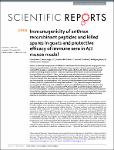Immunogenicity of anthrax recombinant peptides and killed spores in goats and protective efficacy of immune sera in A/J mouse model
Ndumnego, Okechukwu C.
Koehler, Susanne M.
Crafford, Jannie E.
Beyer, Wolfgang
van Heerden, Henriette
Anthrax is primarily recognized as an affliction of herbivores with incubation period ranging from three to five days post-infection. Currently, the Sterne live-spore vaccine is the only vaccine approved for control of the disease in susceptible animals. While largely effective, the Sterne vaccine has several problems including adverse reactions in sensitive species, ineffectiveness in active outbreaks and incompatibility with antibiotics. These can be surmounted with the advent of recombinant peptides (non-living) next generation vaccines. The candidate vaccine antigens comprised of recombinant protective antigen (PA), spore-specific antigen (bacillus collagen-like protein of anthracis, BclA) and formaldehyde inactivated spores (FIS). Presently, little information exists on the protectivity of these novel vaccine candidates in susceptible ruminants. Thus, this study sought to assess the immunogenicity of these vaccine candidates in goats and evaluate their protectivity using an in vivo mouse model. Goats receiving a combination of PA, BclA and FIS yielded the highest antibody and toxin neutralizing titres compared to recombinant peptides alone. This was also reflected in the passive immunization experiment whereby mice receiving immune sera from goats vaccinated with the antigen combination had higher survival post-challenge. In conclusion, the current data indicate promising potential for further development of non-living anthrax vaccines in ruminants.
Files in this item

